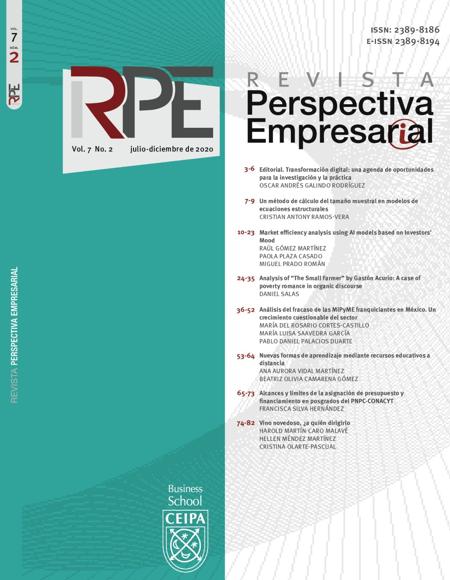Market efficiency analysis using AI models based on Investors’ Mood
##plugins.themes.bootstrap3.article.main##
La hipótesis del mercado eficiente asume que los precios de las acciones en los mercados financieros incorporan toda la información histórica en cualquiera de sus formas (débil, semifuerte y fuerte). El objetivo de este estudio es validar esta hipótesis. Este estudio utiliza modelos de inteligencia artificial diseñados para predecir las tendencias del IBEX con base en el estado de ánimo de los inversores, extrayendo información del big data y utilizando algoritmos de procesamiento del lenguaje natural. Los resultados del estudio muestran que la tasa de éxito de un sistema que se prepara para solo 6 meses es mayor que la de un sistema que utiliza toda la información histórica disponible. Las estrategias de inversión también pueden basarse en las previsiones de los modelos de inteligencia artificial, que pueden superar el mercado, estableciendo diferentes sistemas de negociación para distintos grados de riesgo en función del umbral de probabilidad que proporcione el modelo considerado. Estos resultados implican que el mercado financiero español tiene una memoria de corto plazo y no incluye información más antigua, por lo que no cumple los supuestos de la hipótesis de mercado eficiente.
Downloads
##plugins.themes.bootstrap3.article.details##
Coates, J.M. and Herbert, J. (2008). Endogenous steroids and financial risk taking on a London trading floor. Proceedings of the National Academy of Sciences, 105(16), 6167-6172. https://doi.org/10.1073/pnas.0704025105 DOI: https://doi.org/10.1073/pnas.0704025105
Cohen, G. and Kudryavtsev, A. (2012). Investor Rationality and Financial Decisions. Journal of Behavioral Finance, 13(1), 11-16. https://doi.org/10.1080/15427560.2012.653020 DOI: https://doi.org/10.1080/15427560.2012.653020
Corredor, P., Ferrer, E. y Santamaría, R. (2013). Elsentimiento del inversor y las rentabilidades delas acciones. El caso español. Spanish Journal ofFinance and Accounting, 42(158), 211-237
https://doi.org/10.1080/02102412.2013.10779746 DOI: https://doi.org/10.1080/02102412.2013.10779746
Darling, P.G. (1955). A surrogate measure of business confidence and its relation to stock prices. The Journal of Finance, 10(4), 442-458. https://doi.org/10.1111/j.1540-6261.1955.tb01297.x DOI: https://doi.org/10.1111/j.1540-6261.1955.tb01297.x
Doran, J.S., Peterson, D.R. and Wright, C. (2010). Confidence, opinions of market efficiency, and investment behavior of finance professors. Journal of Financial Markets, 13(1), 174-195.
https://doi.org/10.1016/j.finmar.2009.09.002 DOI: https://doi.org/10.1016/j.finmar.2009.09.002
Edmans, A., García, D. and Norli, Ø. (2007). Sports sentiment and stock returns. The Journal of Finance, 62(4), 1967-1998 https://doi.org/10.1111/j.1540-6261.2007.01262.x DOI: https://doi.org/10.1111/j.1540-6261.2007.01262.x
Fama, E. and French, K. (1998). Market efficiency, longterm returns and behavioral finance. Journal of Financial Economics, 49(3), 283-306. https://doi.org/10.1016/S0304-405X(98)00026-9 DOI: https://doi.org/10.1016/S0304-405X(98)00026-9
Feldman, T. (2011). Behavioral Biases and Investor Performance. Algorithmic Finance, 1(1), 45-55. https://doi.org/10.3233/AF-2011-005 DOI: https://doi.org/10.3233/AF-2011-005
Gómez, R. (2013). Señales de inversión basadas en un índice de aversión al riesgo. Investigaciones Europeas de Dirección y Economía de la Empresa, 19(3), 147- 157. https://doi.org/10.1016/j.iedee.2012.12.001 DOI: https://doi.org/10.1016/j.iedee.2012.12.001
Gómez, R. y Prado, C. (2014). Sentimiento del inversor, selecciones nacionales de fútbol y su influencia sobre sus índices nacionales. Revista Europea de Dirección y Economía de la Empresa, 23(3), 99-114. https://doi.org/10.1016/j.redee.2014.02.001 DOI: https://doi.org/10.1016/j.redee.2014.02.001
Hasanhodzic, J., Lo, A.W. and Viola, E. (2011). A computational view of market efficiency. Quantitative Finance, 11(7), 1043-1050. https://doi.org/10.1080/14697688.2010.541487 DOI: https://doi.org/10.1080/14697688.2010.541487
Hilton, D.J. (2001). The Psychology of Financial Decision- Making: Applications to Trading, Dealing, and Investment Analysis. Journal of Psychology and Financial Markets, 2(1), 37-53.
https://doi.org/10.1207/S15327760JPFM0201_4 DOI: https://doi.org/10.1207/S15327760JPFM0201_4
Hirshleifer, D. and Shumway, T. (2003). Good day sunshine: Stock returns and the weather. The Journal of Finance, 58(3), 1009-1032. https://doi.org/10.1111/1540-6261.00556 DOI: https://doi.org/10.1111/1540-6261.00556
Huynh, T.D. and Smith, D.R. (2017). Stock Price Reaction to News: The Joint Effect of Tone and Attention on Momentum. Journal of Behavioral Finance, 18(3), 304-328. https://doi.org/10.1080/15427560.2017.1339190 DOI: https://doi.org/10.1080/15427560.2017.1339190
Jacobsen, B. and Marquering, W. (2008). Is it the weather? Journal of Banking and Finance, 32(4), 526-540. https://doi.org/10.1016/j.jbankfin.2007.08.004 DOI: https://doi.org/10.1016/j.jbankfin.2007.08.004
Kaplanski, G. and Levy, H. (2010). Exploitable predictable irrationality: The FIFA world cup effect on the U.S. stock market. The Journal of Financial and Quantitative Analysis, 45(2), 535-553. https://doi.org/10.1017/S0022109010000153 DOI: https://doi.org/10.1017/S0022109010000153
Kirilenko, A., Sowers, R. and Meng, X. (2013). A Multiscale Model of High-Frequency Trading. Algorithmic Finance, 2(1), 59-98. https://doi.org/10.3233/AF-13017 DOI: https://doi.org/10.3233/AF-13017
Lemmon, M. and Portniaguina, E. (2006). Consumer confidence and asset prices: Some empirical evidence. The Review of Financial Studies, 19(4), 1499-1529. https://doi.org/10.1093/rfs/hhj038 DOI: https://doi.org/10.1093/rfs/hhj038
Leshik, E. and Crall, J. (2011). An Introduction to Algorithmic Trading: Basic to Advanced Strategies. New Jersey, USA: Wiley. https://doi.org/10.1002/9781119206033 DOI: https://doi.org/10.1002/9781119206033
Liu, S. (2015). Investor Sentiment and Stock Market Liquidity. Journal of Behavioral Finance, 16(1), 51-67. https://doi.org/10.1080/15427560.2015.1000334 DOI: https://doi.org/10.1080/15427560.2015.1000334
Markowitz, H. (1952). Portfolio selection. The Journal of Finance, 7(1), 77-91. https://doi.org/10.1111/j.1540-6261.1952.tb01525.x DOI: https://doi.org/10.1111/j.1540-6261.1952.tb01525.x
Maymin, P. (2011). Markets are Efficient if and Only if P = NP. Algorithmic Finance, 1(1), 1-11. https://doi.org/10.3233/AF-2011-007 DOI: https://doi.org/10.3233/AF-2011-007
Mishra, V. and Smyth, R. (2010). An examination of the impact of India's performance in one-day cricket internationals on the Indian stock market. Pacific- Basin Finance Journal, 18(3), 319-334. https://doi.org/10.1016/j.pacfin.2010.02.005 DOI: https://doi.org/10.1016/j.pacfin.2010.02.005
Moat, H. et al. (2013). Quantifying Wikipedia usage patterns before stock market moves. Scientific Reports, 3, 1-5. https://doi.org/10.1038/srep01801 DOI: https://doi.org/10.1038/srep01801
Narayan, S. and Narayan, P.K. (2017). Are Oil Price News Headlines Statistically and Economically Significant for Investors? Journal of Behavioral Finance, 18(3), 258-270. https://doi.org/10.1080/15427560.2017.1308942 DOI: https://doi.org/10.1080/15427560.2017.1308942
Nofsinguer, J.R. (2005). Social Mood and Financial Economics. Journal of Behavioral Finance, 6(3), 144-160. https://doi.org/10.1207/s15427579jpfm0603_4 DOI: https://doi.org/10.1207/s15427579jpfm0603_4
Olsen, R.A. and Cox, C.M. (2001). The Influence of Gender on the Perception and Response to Investment Risk: The Case of Professional Investors. Journal of Psychology and Financial Markets, 2(1), 29-36. https://doi.org/10.1207/S15327760JPFM0201_3 DOI: https://doi.org/10.1207/S15327760JPFM0201_3
Schmitz, J. (2010). Algorithmic Trading in the Iowa Electronic Markets. Algorithmic Finance, 1(2), 157-181. https://doi.org/10.3233/AF-2011-012 DOI: https://doi.org/10.3233/AF-2011-012
Seyhun, H.N. (1988). The January effect y aggregate insider trading. The Journal of Finance, 43(1), 129-141 https://doi.org/10.1111/j.1540-6261.1988.tb02593.x DOI: https://doi.org/10.1111/j.1540-6261.1988.tb02593.x
Shang, Z., Brooks, C. and McCloy, R. (2014). Does more detailed information mean better performance? An experiment in information explicitness. Review of Behavioural Finance, 6(2), 86103. https://doi.org/10.1108/RBF-10-2013-0036 DOI: https://doi.org/10.1108/RBF-10-2013-0036
Sharpe, W. (1994). The Sharpe ratio. The Journal of Portfolio Management, 21(1), 49-58. https://doi.org/10.3905/jpm.1994.409501 DOI: https://doi.org/10.3905/jpm.1994.409501
Shiller, R.J. (2000). Measuring Bubble Expectations and Investor Confidence. Journal of Psychology and Financial Markets, 1(1), 49-60. https://doi.org/10.1207/S15327760JPFM0101_05 DOI: https://doi.org/10.1207/S15327760JPFM0101_05
Yuan, K., Zheng, L. and Zhu, Q. (2006). Are investors moonstruck? Lunar phases and stock returns. Journal of Empirical Finance, 13(1), 1-23. https://doi.org/10.1016/j.jempfin.2005.06.001 DOI: https://doi.org/10.1016/j.jempfin.2005.06.001
Wu, K. et al. (2013). A Big Data Approach to Analyzing Market Volatility. Algorithmic Finance, 2(3-4), 241-267. https://doi.org/10.3233/AF-13030 DOI: https://doi.org/10.3233/AF-13030


































